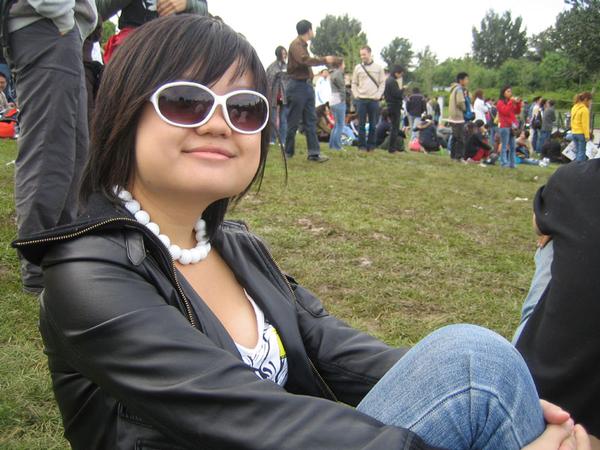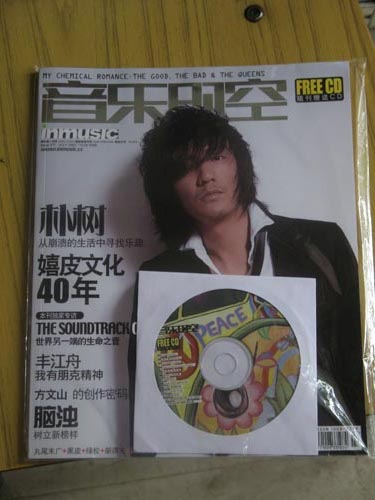Lua Zhou sits in the meeting room of a pleasantly appointed office in the Spaces complex on Dongdaqiao Lu in Beijing’s central business district. Respectable digs for a Chinese rock magazine, I remark. But then the editor of InMusic points me to the advertising: European cars, French perfume, American clothes.
A fan of British punk and an reader of NME and Kerrang when both publications were hard to get in China or online, this sweet, bubbly 27 year old talked me through the RMB15 (EUR1.45) monthly magazine put together in Beijing by a staff of ten and a circle of freelance writers.

A print run of 120,000 copies of I Music is distributed monthly to all major Chinese cities. Sales are strongest in Shanghai. The magazine sells particularly well in airports. A magazine already in circulation in Guizhou - published under the auspices of an artists’ organisation in the rural southern province - provided the all important government-approved "kan hou", a barcode without which magazines can't get distributed in China.
The editorial engine behind the magazine, Hao Fang, was a music critic in the 1990s, a "godfather of Chinese rock kids," says Lua. "He wrote books about Nirvana and New York punk bands." Lua was one of the Beijing rock fans who congregated at a book store he ran near Beijing Exhibition Centre. "You could buy under ground music magazines and books from abroad. He had demo tapes and even posters done by the bands themselves. Hao was also one of the "first people in China to publish nude photos from the foreign rock scene." Though China has a long history of publishing nude photos in ancient times, says Lua, "...his book surprised me."
Hao's magazine hit the streets in March 2006 as the Chinese edition of Rolling Stone, launched to huge fanfare in the international press. Rolling Stone China put the likes of Bob Dylan and local rock godfather Cui Jian on the cover. Then the venture’s Hong Kong partner and advertising sales agency One Media pulled out to concentrate on middle class glossies like Ming, making money off the gentrification of the Chinese masses. Lua is uncomfortable talking about the Rolling Stone episode, only repeating that the transition between the two publications is "complicated... We erased the Rolling Stone logo in July 2007, which means we called ourelves InMusic starting from July 2007."
Rolling Stone China was criticised by some readers for mediocre writing and a lack of the punchy political writing which the original US edition carried off to some acclaim. Good scribes are hard to find, says Lua whose southern Chinese shyness ebbs when talking about British bands like the Babyshambles. "If you’re in the circle you know who is good writer." She studied journalism at the University of Minorities in Beijing as well as a stint at the University of Westminister in the UK.
IMusic content splits 50/50 between local and foreign coverage. "We choose the best demos of the month and always go to shows. We’re the ones there every night, talking and taking photos. If we fancy a band we sometimes ask them to send a CD, but we have loads coming in. Out of 100 we choose ten."
CDs come in from the Chinese branch offices of the four majors and a new wave of Chinese Indie labels. "There are more labels than ever," says Lua. Most were set up by musicians. The most visible, Modern Sky and Scream were both set up by musicians, the latter as a sublabel of state-owned distributer Jingwen. A newer start up, Bing Ma Si is the side project of Yang Hai Sun, stalwart of Sino-Swedish punks PK14.
The Rolling Stone logo is gone but the IMusic strategy is strikingly similar to the iconic US publication, which long ago lost its countercultural edge to more alternative magazines like the Village Voice. Advertising from car makers like Volkswagen as well as cellphone and drinks brands because the magazine keeps its standards, says Lua.
"The big difference between us and other rock magazines is that we haven’t so many instrument shops advertising. Our advertising sales team is very good, they don’t just focus on music.” An in-house survey showed most of the title’s readers are well educated professionals. "Young professionals have the potential to buy a car. The typical reader surfs the web for information and speaks a foreign language."
Corporate marketing budgets have been convinced, but it’s part of a trend towards an acceptance of rock among China’s middle class youth, says Lua. "More brands are keen to invest in rock concerts. More and more of the mainstream majority are opting for rock.” IMusic covers "youth culture rather than rock culture.” Hence an editor is assigned to hang out at 798 covering the contemporary art scene.
InMusic's Johnny Depp cover in August 2006 proved the biggest seller. "Everyone can accept him, especially music lovers because he had a band." Covers depend on who has a new album out. The July issue was Pu Shu, a pop rocker with a chequered life story and big CD sales in 1999 and 2000. "He stopped making music and disappeared to Tibet and abroad. An InMusic journalist shadowed him for a week and we printed his new writing and songs from his travels.” Pu was also chosen for looks. "Girls are crazy for him.”

Reportage on local rock accounts for about a quarter of the page count in the most recent issue of InMusic. "The most popular genres in Beijing right now are post punk and new grunge, Queen Sea Big Shark is new grunge. Retros is post punk," explains Lua by way of two of the city's most current groups. Luo has an easiness with labels and categories, referencing musicians by genre. Her early favourites The Flowers went from being an "underground punk band" to a "pleasant soft pop band."
Beyond Beijing IMusic generates a good share of its monthly copy in the central Chinese metropolis of Wuhan, home to a vibrant punk scene. "People there come out and promoted themselves. The scene grew from Wuhan University, from a lot of campus bands." The wealthy Cantonese city of Guangzhou, being by the sea, has good access to cheap imported CDs. "It has a very good scene and good critics."
InMusic pushes newcomers it figures worthy of notice. The magazine's New Face Bands stage at October’s Modern Sky rock festival gave half hour sets to fresh local faces featured in the magazine - and girl bands. "People need to know the new bands and we want to be promoter.” It helps that half of InMusic staff writers are also musicians. "One of the girls is in a post punk band." Executive editor Cheizak organizes hip hop shows and produces hip hop albums.
Lua sings. Her band Happy Project has however momentarily lost its keyboard player to a cooking course in Vietnam. They play "disco punk, music that people can dance to." Influences include the Scissors Sisters and Electric 6.
She started listening to music in high school back home in the urban industrial jungle that is Chongqing. "I got Nirvana and Eagles albums from my piano teacher’s son." She liked local stars like Bao Jia Jie 43 Hao and the group's frontman Wang Feng, currently a credible solo artist.
Rock took Lua out of Chongqing "because there was no bands there, and no venues. Beijing is a melting pot, so you get more space away from hometown traditions and rules. Shanghai girls are local girls, whereas Beijing is a mix of locals and country girls, so there’s more culture."
Beijing also had better music shops. She started buying US blues, "Buddy Guy and JL Hooker." Studying in the UK was also about music. A London concert by the Libertines "was like a revolution, it was so mad. I lost all my accessories while I was in the front row pogoying." Lua estimates she spent half her UK time going to gigs. The best show she’s seen in beijing was Nine Inch Nails, for its sound and visual qualities.
Fashion is important to Chinese rock. An October headlining set by the Yeah Yeah Yeahs at the marked a rain-sodden but spirited end to the innaugural Modern Sky festival in Haidian Park. Local fans remember it for lead singer Karen O's look on the night. "She wasn’t well. It wasn’t the best side of her." The avant-garde New Yorker has become an icon among Chinese girls as much as a fashion model as for her music and stage craft.
"They want to dress like her, to wear shiny tight pants and loud lipstick. Some girls are not confident enough to be on stage." To bring in extra cash InMusic also runs its own line of t-shirts. A top seller, by mail order, bears an image of a fishnetted but badly proportioned Rock Girl. Her legs aren’t well aligned but even at a compartively steep RMB80 sales are good.
More ...
[Read more...]